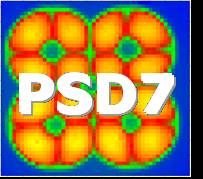Speaker
Mr
Hironobu Nishimura
(Kyoto University, Japan)
Description
We have developed a position-sensitive scintillation camera with an
area of 15×15cm2 for absorber of a Compton gamma-ray camera for
astronomy. It consists of 3×3 array of position sensitive PMTs
(Hamamatsu Flatpanel H8500). Each PMT has 8×8 anodes with a pitch of
6mm and is coupled to 8×8 array of pixelated 6×6×13mm3 GSO
scintillators.
We chose the GSO scintillator because it has advantages in
astronomical use, such as high radiation hardness and high stopping
power. The crystal surface was polished by chemical etching. We
adopted 3M ESR(Enhanced Specular Reflector) film with a thickness of
65μm as reflector of the scintillator. Therefore, we can increase
the effective area of scintillator array to 97.8% from 93.4 % in
case of Teflon with a thickness of 200μm. Total effective area of
our scintillation camera with size of 15×15cm2 was improved to 80%.
In order to reduce power consumption in a balloon-born experiment,
the number of readout channels was reduced by using chained
resistors. The signals from 24×24 anodes were readout through 48
channels. The energy resolution was 7.1%(FWHM) at 1275keV, 9.8% at
662keV and 24.3% at 122keV. The position of incident gamma ray was
calculated on the principle of charge division method, and each
pixel in flood field irradiation image was able to be clearly
resolved.
Aiming at higher energy resolution we have been studying Zr/Ce-
codoped GSO scintillators, because its light output is larger than
that of conventional Ce-doped GSO. Furthermore in order to improve
position resolution we have been developing 16×16 array of pixelated
3×3×13mm3 GSO scintillators coupled to the PSPMT. These results will
also be presented.
Primary author
Mr
Hironobu Nishimura
(Kyoto University, Japan)

